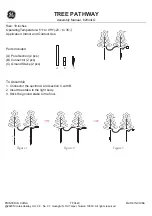
5
2. Connect the tube for the back pressure switch to the inducer
assembly (PSC only).
3. Connect the tube for the front pressure switch or pressure
transducer to the port on the collector box (PSC only).
4. Attach the pressure switch assembly to the inducer.
5. Connect the pressure switch harness (modulating only) to
the main wiring harness or attach the individual wires to the
pressure switch (non--modulating).
6. If necessary, route the pressure switch tubing for the front
pressure switch through the stand--off on the inducer
assembly.
7. If necessary, route the condensate trap relief tubing through
the stand--off on the inducer assembly. Reconnect tubing to
the ports on the condensate trap and collector box.
Inducer Outlet Restrictor (PSC models only)
On 40,000 BTUH input models on vent systems under 10 ft. in
length, an inducer outlet restrictor is required at altitudes under
2000--ft (610 M). The outlet restrictor snaps into the outlet of the
inducer assembly. If the Outlet restrictor was installed in the old
inducer, remove it and re--install it in the replacement inducer.
To install the outlet restrictor:
1. Align the lock tabs on the outlet restrictor with the slots on
inside outlet of the inducer assembly.
2. Snap the outlet restrictor in place.
3. Install the vent elbow in the required orientation.
4. Torque vent elbow clamp 15 lb--in.
PSC INDUCER ASSEMBLY
INDUCER OUTLET
VENT ELBOW CLAMP
TORQUE 15 LB-IN.
VENT PIPE CLAMP
TORQUE 15 LB-IN.
VENT ELBOW
INDUCER OUTLET CHOKE
40,000 BTUH MODELS ONLY
10 FT. OF VENT OR LESS
A150624
Fig. 6 -- Outlet Choke Installation
Vent Pipe Installation
1. Orient the vent elbow in the required location. Torque the
vent elbow clamp 15 lb--in.
2. Insert the vent pipe through the furnace casing and into the
outlet of the inducer vent elbow.
3. Tighten the clamp for the vent pipe at vent elbow on the
inducer assembly.
4. Align the remaining vent pipe system to the vent pipe in the
furnace casing.
5. Solvent cement the pipes as required for the type of material
used.
6. Tighten both clamps at the vent pipe support attached to
furnace casing.
Unit Checkout
1. Set thermostat to “OFF”.
2. Turn on power at external disconnect, fuse or circuit
breaker.
3. Turn on gas at external shut-off or gas meter.
FIRE AND EXPLOSION HAZARD
Failure to follow this warning could result in a fire, explosion,
personal injury or death.
NEVER purge a gas line into a combustion chamber. NEVER
test for gas leaks with an open flame. Use a commercially
available soap solution made specifically for the detection of
leaks to check all connections. A fire or explosion may result
causing property damage, personal injury, or loss of life.
!
WARNING
RISQUE D’EXPLOSION ET D’INCENDIE
Le non--respect des avertissements de sécurité pourrait
d’entraîner des blessures graves, la mort ou des dommages
matériels.
Ne jamais utiliser une flamme nue por vérifier la présence des
fuites de gaz. Pour la vérification de tous les joints, utiliser
plutôt une solution savonneuse commerciale fabriquée
spécifiquement pur la détection des fuites de gaz. Un incendie
ou une explosion peut entraîner des dommages matériels, des
blessures ou la mort.
!
WARNING
4. Check for gas leaks with a commercially available soap
solution made specifically for the detection of leaks.
5. Manually close blower door switch.
ELECTRICAL OPERATION HAZARD
Failure to follow this warning could result in personal injury
or death.
Blower door switch opens 115--v power to control. No
component operation can occur unless switch is closed.
Caution must be taken when manually closing this switch for
service purposes.
!
WARNING
6. Initiate component test through circuit board by referring to
“Component Test”
on status code label on blower access
door for complete test sequence information.
7. If any status codes are flashed, refer to status code label on
unit blower door.
8. Turn thermostat fan switch to “ON”, “Continuous” or
jumper R to G terminals at furnace control board.
9. Check for air leakage around cell panel.
10. Remove jumper(s) or set thermostat fan to “Auto” or “OFF”
11. Release blower door switch
12. Install blower access door
13. Set thermostat to call for heat.
14. Allow unit to initiate a complete call for heat cycle.
15. Check for air leakage around collector box. A whistling
noise may indicate air leak in collector box seal.
NOTE
: If there is a severe air leak in the collector box seal,
pressure switch may not close or will re-open, resulting in no
ignition or erratic burner operation.
NOTE
: As part of the system check-out, verify that the following
conditions are not affecting the operation of the furnace:
S
Short Cycling-Defective thermostat: Incorrect thermostat
anticipator setting, dirty filter or over-sized furnace.
S
Under firing/low BTU input: Set manifold pressure and verify
337938
























